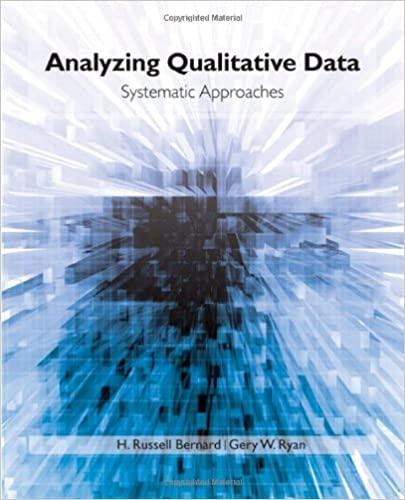Question
11. According to the module reading by Hofstede (2011), regarding power distance the following is/are true: A. involves greater resistance to power inequality by those
11. According to the module reading by Hofstede (2011), regarding "power distance" the following is/are true:
A. involves greater resistance to power inequality by those who are less powerful
B. involves greater resistance to power inequality by those who are more powerful
C. it tends to be least in Eastern Europe, Latin countries, Asia, and Africa
D. it tends to be greatest in Eastern Europe, Latin countries, Asia, and Africa
12. According to the module reading by Hofstede (2011), uncertainty avoidance is encouraged by some nations, via:
A. possessing strict rules concerning behavior
B. clear guidelines as to educational norms
C. tolerating deviant opinions more
D. a strong educational tradition
13. According to the module reading by Hofstede (2011) regarding individualism/collectivism:
A. loyalty to the in-group may be expected more in nations that tend to be collectivistic
B. maintaining order is not given as high a priority, in collectivistic countries
C. loyalty to the in-group may be expected more in nationas that tend to be individualistic
D. maintaining order is not given as high a priority, in individualistic countries
14. According to the module reading by Hofstede (2011) regarding indulgence/restraint:
A. students in countries found to be more restrained, are more likely to attribute failure to not having tried hard enough
B. in countries found to be more indulgent, mothers tend to decide on number of children their families will have
C. it correlates weakly with long/short term orientation
D. loyalty to the in-group may be expected more in nationas that tend to be indulgent
15. According to the module reading by McCrae (2002), the NEO-PI-R (Costa & McCrae, 1992):
A. has been validated but not replicated
B. has 40 items
C. has five factors
D. has been translated into 30 languages/dialects
16. According to the module reading by McCrae (2002), a wide variety of measures of the FFM have now been developed; however, the following is the most widely used:
A. Elemental Psychopathy Assessment
B. Cross-Functional Personality Inventory
C. Revised NEO Personality Inventory
17. How can the average differences between genders, on the five factors in the Five Factor Model of personality traits, be characterized?
A. each between-gender, average difference in a factor, is smaller than the within-gender difference in that factor
B. none of the other answers given here is correct
C. these have only been observed in the U.S.
D. each between-gender, average difference in a factor, is larger than the within-gender difference in that factor
18. The following are average gender differences in the Five Factor Model factors, as found in the U.S.:
A. men were more open to experience, on all facets, than were women
B. women were higher than men in conscientiousness
C. women were higher in extraversion, on some facets, than were men
D. women were lower than men in agreeableness
19. Each of the five factors in the Five Factor Model, is measured on a unipolar continuum.
A. true
B. false
20. One reason it is important to consider the use of indigenous approaches to personality trait research, rather than automatically using the Five Factor Model (FFM), is
A. the FFM has not been replicated
B. the FFM was developed in the U.S., in English
C. none of the other answers given here is correct
Step by Step Solution
There are 3 Steps involved in it
Step: 1

Get Instant Access to Expert-Tailored Solutions
See step-by-step solutions with expert insights and AI powered tools for academic success
Step: 2

Step: 3

Ace Your Homework with AI
Get the answers you need in no time with our AI-driven, step-by-step assistance
Get Started


